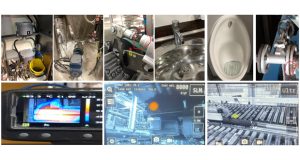 Dave Peacock, Technical Director of TÜV SÜD Building Advisory Service on modernising building façade inspection with the use of drones and artificial intelligence (AI)
Dave Peacock, Technical Director of TÜV SÜD Building Advisory Service on modernising building façade inspection with the use of drones and artificial intelligence (AI)
Following key proposals made by Dame Judith Hackitt after the Grenfell Tower disaster, the UK’s Building Safety Bill is expected to come into force in 2023. This will ensure accountability for those involved in the lifecycle of high-rise residential buildings that are 18 metres high or have at least seven stories, and that have at least two residential units. These regulatory changes are likely to have major financial and practical consequences for the facilities management sector, especially as it is anticipated that the type of buildings included within the bill will broaden over the coming years.
Under UK law, building owners and occupiers have a legal duty to ensure their building is safe, to mitigate injury or damage being caused to people or property. Since 1994 all new and refurbished buildings are also required to have a maintenance manual, which must be kept up to date and any necessary maintenance work carried out.
Insurance will also require building owners to show that the relevant maintenance needs have been met. Failure to maintain a building façade properly may result in increased insurance premiums, difficulty in obtaining insurance renewals, or the termination of insurance cover. It is therefore vital that those responsible for a building’s maintenance and upkeep can demonstrate to insurers that all reasonable steps have been taken by implementing appropriate risk management procedures. This should include periodic façade inspection.
FAÇADE INSPECTION
The degree of façade inspection and maintenance that is required will depend on the materials used and its intended life. In the UK, the necessary frequency of inspection is divided into three categories:
- Routine – continuous regular observations that should be undertaken by the user as part of the occupancy of the building.
- General – visual inspections of main elements.
- Detailed – a full inspection of the façade by a suitably qualified person.
Periodic façade inspection will help to detect potential issues and underlying problems with a façade early on, such as cracks, corrosion and flaking. It will also help to identify the level of defect deterioration and minimise the risk of any compromised facades exposing safety risks.
Façade inspection is therefore vital to support facilities managers and owners of large high-rise buildings. As an integral part of any building survey, it helps to verify the integrity of the building structure and ensures safety for a building’s occupants and people within its vicinity. However, conventional façade inspection usually requires roof access and involves the use of gondolas all of which is time, labour and cost intensive. It is also highly disruptive for occupants, and dangerous for inspectors due to the difficulty of accessing high-rise buildings.
OPTIMISE ACCESS
Many building managers and owners will already have access to or will have invested in a façade access system for cleaning and other maintenance needs, such as checking lighting, photovoltaics, louvres and vents. A good façade maintenance solution should already optimise the access equipment against the complexity of the building’s façade. Such systems include suspended platforms, roof trolleys and dedicated platforms, and mobile elevated work platforms. So, the question is, why can’t these systems also be used to provide detailed building surveys?
For the outside of a building to maintain its aesthetic appeal, it must be regularly cleaned and maintained. Also, insurance warranties for facades usually mandate that cleaning and maintenance cycles remain unaffected. Economical and effective façade maintenance is therefore now a prime consideration within the overall building design process. So, existing façade maintenance systems cannot be diverted to dedicate time to more detailed survey work that could be easily completed by drones.
Likewise, employers must ensure, so far as is reasonably practicable, the health, safety and welfare of their employees and to ensure that those affected by their activities are not exposed to risk. Falling from height is likely to happen when operatives are getting in to and out of the manned platform, usually because safe access points are not provided. They can also sometimes become trapped in the manned platforms due to a mechanical or operational failure, and it has been known for equipment to accidentally tip when it snags on something protruding from the building. Using drones takes away this additional risk for the detailed surveying of façades.
For buildings that are 30 years or older, it is highly unlikely that any digital information about a building is available. Also, buildings of historical interest will not be able to use permanently mounted façade access systems for maintenance and cleaning. So, drones make sense in terms of reducing any complexities and costs when detailed surveys of the building are required.





